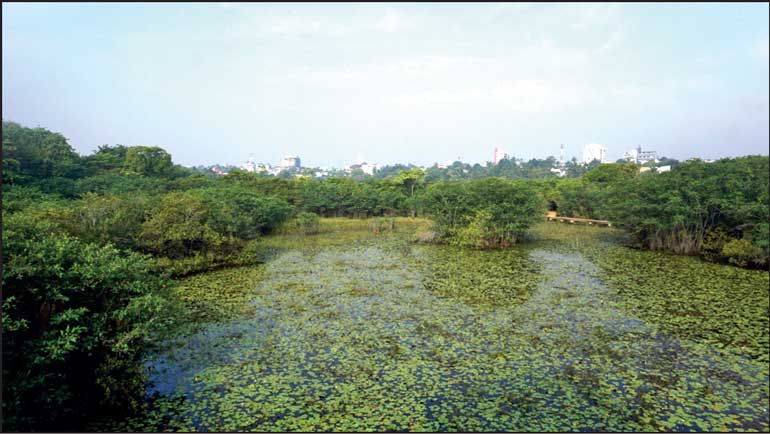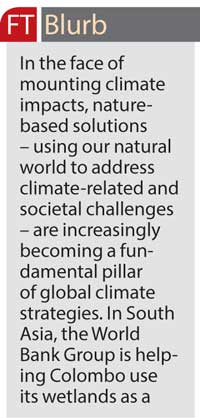Saturday Dec 14, 2024
Saturday Dec 14, 2024
Wednesday, 2 February 2022 00:00 - - {{hitsCtrl.values.hits}}


By Caitriona Mary Palmer, Priyanka Dissanayake, Nandya Thalyta Yuwono and Nadeera Rajapakse
Perched on the coastline of the Indian Ocean, set amidst a backdrop of soaring office blocks, colonial buildings, temples and minarets, Colombo, the capital city of Sri Lanka, looks like any other dynamic South Asian urban metropolis.
But interspersed between Colombo’s urban landscape lies a teeming network of wetland ecosystems – nearly 20 square kilometres of freshwater lakes, wet woodlands, wet grasslands and swamps bursting with pink lotus flowers, spotted butterflies and the elusive, stealthy fishing cat.
In the face of mounting climate impacts across South Asia, Colombo’s wetlands have become a key solution for the flood-prone city’s future.
Wetlands – a natural defence to flooding – act as giant sponges, soaking up flood waters and releasing them once the high water has receded. They also bring other benefits to city residents, operating as natural air conditioners, water and air purifiers, carbon sinks, agricultural havens and safe harbours for biodiversity.
water and air purifiers, carbon sinks, agricultural havens and safe harbours for biodiversity.
Now, supported by the World Bank, Colombo’s wetlands – after years of neglect and encroachment – are being conserved and revitalised. For nearly a decade, the Metro Colombo Urban Development project (MCUDP) has combined engineering and environmental science to implement flood mitigation, urban upgrading and wetland conservation. The goal of the project is not just to prevent future flooding with hard infrastructure, but to reposition urban parks and wetlands as the beating heart of city life.
A mission to protect every inch of Colombo’s wetland
In November 2010, the heaviest rains in 18 years inundated Colombo, displacing residents from their homes, submerging the parliament building under several feet of water and bringing the capital’s economic life to a grinding halt for nearly a week.
Colombo, a city crisscrossed by an extensive network of man-made and natural canals and waterways, was no stranger to flash flooding. For generations, the city’s wetlands have been progressively degraded, filled-in and lost. With an average loss of 58 acres a year, much of this damage is considered irreversible.
In 2012, the Government of Sri Lanka asked the World Bank’s Global Facility for Disaster Reduction and Recovery (GFDRR) to conduct a technical study – the Metro Colombo Urban Wetland Management Strategy – to assess the flood risk in the capital and to examine the range of benefits that the wetlands bring.
One of the most comprehensive assessments conducted on an urban wetland anywhere in the world, the study provided incontrovertible proof of the central role that Colombo’s wetlands played in flood prevention and in the general well-being of the city’s citizens. During intensive rainfall, Colombo’s wetlands are estimated to store several million cubic meters of water – the equivalent of more than 27,000 Olympic-sized swimming pools.
“The hydrological model provided damning evidence that even if we installed drainage tunnels, pumping stations and improved canal diversion throughout the city, we still couldn’t keep Colombo completely safe from a major flood without preserving the wetlands,” said Nandya Thalyta Yuwono, the World Bank team leader for the MCUDP.
Wetlands, a systemic lifeline for all
For the more than half a million residents who live within Colombo’s urban limits, the technical assessment also validated the benefits that the city’s wetlands provide on a day-to-day basis.
Colombo’s wetlands act as natural air conditioners, thanks to the dark open water and vegetation which absorb more solar radiation. As nature’s kidneys and lungs, they clean Colombo’s water, removing pollutants and waste that leach into the city’s waterways and canals. They are also carbon sponges, absorbing up to 90% of Colombo’s greenhouse gas emissions and purifying the air.
Colombo’s wetlands teem with over 280 species of wildlife including the endangered fishing cat, saltwater crocodile, purple faced leaf monkey, Eurasian otter, porcupines, and birds—both migratory and resident. They are also home to the vulnerable rusty spotted cat – the world’s smallest feline.
A tropical home to more than 250 types of plants, for centuries Colombo’s residents have cultivated rice in the city’s urban paddy fields, fished in the canals, and picked herbs for use in Ayurvedic medicine. Nearly 90% of the city’s wetlands provide food and supplemental income for Colombo’s urban poor.
Economic concerns about flooding – estimates suggest that Colombo could lose 1 percent of GDP on average every year due to a major flood – soon gave way to an understanding that preserving the wetlands would provide far greater human savings. Robert McInnes, the Team Leader developing the Wetland Management Strategy, urged the MCUDP team in the early days not to limit the scope of the project to just flooding.
“If we had just focused on flooding, we would have caused more problems,” McInnes said. “We must think systemically about the value of wetlands to human society. Not just today, but for three or four generations away.”
Public spaces for all
In 2018, thanks to a newly created Wetland Management Division to preserve Colombo’s wetlands, the government began implementing a two-prong approach: preserving Colombo’s wetlands while also installing pumping stations and tunnels to divert future flood waters. That same year, the government introduced a cabinet paper to place a moratorium on wetland filling across Colombo and to declare the wetlands as official wildlife zones.
These flood control and drainage systems – which includes a sophisticated integrated flood management system -- benefits about 2.5 million of Colombo’s residents by improving the city’s canals, retention areas, and helping to drain the Colombo Water Basin. The project also rehabilitates and manages street and drainage infrastructure and improves solid waste collection.
The $ 320 million MCUDP project has also created public wetland parks for the wise use of city’s wetlands in areas such as Beddagana and Kotte Ramparts, where visitors can stroll on recreational walkways through rejuvenated wetlands.
In 2018, Colombo was declared the first world capital to be accredited as an International Wetland City by the Ramsar Convention on Wetlands, a global convention made up of nearly all UN member states to protect the world’s wetlands.
Now, thanks to the success of the MCUDP, the government of Sri Lanka intends to replicate wetland preservation across the country. To date, Sri Lanka’s Urban Development Authority has approved 49 development plans for conserving wetlands across Sri Lanka with 21 more in development.
Scaling up NBS requires systemic change
Scaling up nature-based solutions (NBS) will require a generations-long focus of treating warming and nature loss as two parts of the same problem, experts say. It will necessitate a shift from specific site-based approaches to a singular systems-based approach that encompasses markets, society, financial systems and ecology as a whole.
“Instead of seeing the protection of wetlands or other ecological systems as something to do from the generosity of our hearts, it should be viewed as essential as maintaining a utility like roads or bridges,” said Dr. Radhika Murti of the International Union for Conservation of Nature (IUCN).
Proper infrastructure financing, combined with policy frameworks, can help unlock financing for NBS. So too can development institutions like the World Bank and projects like MCUDP, which can help countries across South Asia integrate “green” infrastructure – forests, wetlands and mangroves – into human built “gray” infrastructure to better address climate and ecosystem risks and enhance human health and wellbeing.
Caitriona Mary Palmer is Senior Consultant , Climate Business Department at IFC; Priyanka Dissanayake is Disaster Risk Management Specialist, World Bank; Nandya Thalyta Yuwono is Senior Urban Specialist, World Bank and Nadeera Rajapakse is Environmental Specialist, World Bank.